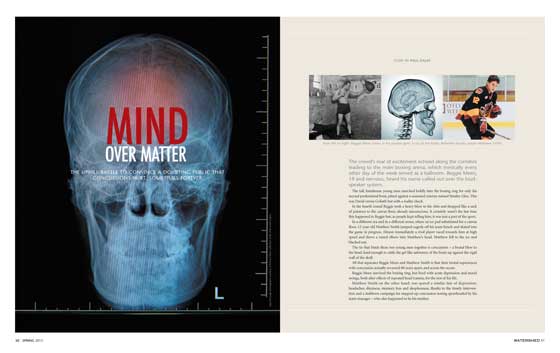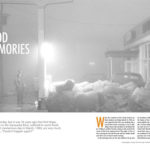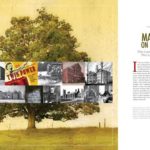
The uphill battle to convince a doubting public that concussions hurt, sometimes forever.
The crowd’s roar of excitement echoed along the corridors leading to the main boxing arena, which served as a ballroom. Reggie Meen, 19 and nervous, heard his name called out over the loudspeaker.
The tall, handsome young man marched boldly into the boxing ring for only his second professional bout, pitted against a seasoned veteran named Stanley Glen. This was David versus Goliath but with a reality check.
In the fourth round Reggie took a heavy blow to the chin and dropped like a sack of potatoes to the canvas floor, already unconscious. It certainly wasn’t the last time this happened to Reggie but, as people kept telling him, it was just a part of the sport.
In a different era and in a different arena, where an ice pad substituted for a canvas floor, 12-year-old Matthew Smith jumped eagerly off his team bench and skated into the game in progress. Almost immediately a rival player raced towards him at high speed and drove a raised elbow into Matthew’s head. Matthew fell to the ice and blacked out.
The tie that binds these two young men together is concussion – a brutal blow to the head, hard enough to rattle the gel-like substance of the brain up against the rigid wall of the skull.
All that separates Reggie Meen and Matthew Smith is that their brutal experiences with concussion actually occurred 80 years apart, and across the ocean.
Reggie Meen survived the boxing ring, but lived with acute depression and mood swings, both after-effects of repeated head trauma, for the rest of his life.
Matthew Smith on the other hand, was spared a similar fate of depression, headaches, dizziness, memory loss and sleeplessness, thanks to the timely intervention and a stubborn campaign for stepped-up concussion testing spearheaded by his team manager – who also happened to be his mother.
SILENT EPIDEMIC
And yet, remarkably over the eight decades separating these two young athletes, organized sport and the community at large continue to treat the silent epidemic of concussions with an almost cavalier disregard.
Two new major reports released in Ontario send a clear and disturbing message: the most vulnerable concussion victims are our children, and we are still sending them back into their sports activities far too quickly after suffering head trauma.
Researchers from York University and the Institute for Clinical Evaluative Sciences (ICES) collected statistics from hospital emergency departments across Ontario. They discovered that in a single year, those hospital ERs treated 10,000 boys and 5,000 girls for concussions. “The numbers are quite staggering. That’s a lot of heads,” says lead author Alison Macpherson, a professor at York’s School of Kinesiology and Health Science.
“You can’t see a concussion. Traditional imaging like a CT scan or MRI doesn’t pick it up. So concussions are hard to diagnose, except based on symptoms. It’s really time for concussions to be better understood and recognized, especially in our kids.”
And although the medical profession is getting better at diagnosing concussions in children, another new research study showed the vast majority of doctors – more than half – actually ignored the recommended criteria for rest, and sent kids back to school and sport too quickly.
Dr. Roger Zemek, who is leading the research on diagnosing and treating concussions at the Children’s Hospital of Eastern Ontario, wants to ensure that parents and medical practitioners are aware of and using the latest information on concussions. “This is so important because children get more concussions than adults do, with increased risk because their brains are still developing.”
It’s a sobering thought that in many areas of high school-age sports, the recommended guidelines for rehabilitating youngsters who suffer a concussion are still not being followed. The misconception that concussion is “just a ding that makes you see stars” will assuredly be heard in a high school somewhere in Ontario every week.
It is a key reason why Dr. Charles Tator, famed neurosurgeon and Canada’s “guru” of concussion, argues Ontario should follow the lead set by the State of Washington: make concussion education mandatory for all players, parents and coaches in high school-aged sports.
“Our knowledge about concussion, based on what we know about repetitive blows to the brain, has increased enormously,” Dr. Tator said in an interview. “We now regard concussion as a significant public health problem.”
A PUBLIC HEALTH PROBLEM
Dr. Tator, who famously challenged TV pundit Don Cherry for advocating violent aggression in hockey, points out that the actual number of concussions is still going up, despite better medical knowledge and increased public awareness.
And it’s not just the obvious contact sports like hockey or boxing that pose a high risk. Sports-minded Canadians who cycle, dive, skateboard or play other collision sports, such as baseball, basketball, soccer, rugby, football, can all sustain concussions.
That’s why Dr. Tator and his team at the Krembil Neuroscience Science Centre Sports Concussion Project at the Toronto Western Hospital push ahead with their ground-breaking research – examining the brains of deceased athletes for signs of chronic traumatic encephalopathy (CTE).
CTE is a progressive degenerative brain disease found in people with a history of repetitive brain trauma, including concussions. It was once called “punch-drunkenness” or dementia pugilistica. The list of pro athletes toppled by CTE (through suicides or early retirement) is a long one, including: Calgary WWE wrestler Chris Benoit who committed suicide after killing his wife and son; former Toronto Maple Leafs enforcer Wade Belak who committed suicide after long bouts of depression; and to date, 33 deceased NFL players who have been diagnosed with CTE after autopsies of their brains.
“We want to study not only the professional athletes, but also the amateurs who have taken blows to the head and are suffering. If they die, we want their brains,” Dr. Tator said. “We want to see what the brain looks like in people who are suffering post-traumatic problems.”
One parent who certainly gets Dr. Tator’s message is Matthew Smith’s mother, Vicki Smith. Her wake-up call came the night she watched helplessly as her son became a casualty statistic playing a sport he loved at the Memorial Arena in Belleville.
THE WHOLE SCARY BIT
“Matthew was put on a stretcher on the ice and taken by ambulance to Belleville General Hospital. That was the whole scary bit,” Vicki recalled. “I was worried he would have swelling on the brain. All kinds of things went through my mind.”
Vicki and her husband Peter, who owns the GM dealership in Belleville, kept their son out of hockey for a month while he recovered from his concussion. Then they realized there was no established test to prove that he was indeed fit to play again.
“It made me realize that this was a very serious situation. I just didn’t like the fact that players were sent back on the ice without being properly tested,” Vicki explained.
Further research by Vicki revealed that a successful baseline testing program had been developed by medical scientists in Pittsburgh but she was unable to convince Ontario minor hockey officials to commit to the program. Cost was a factor; each kit cost $25.
But Vicki Smith was not about to take ‘no’ for an answer. “When Matthew wanted to go back into the game the following season, that’s when we decided to start our own trial program in Belleville with baseline testing. It was a pilot project for Belleville Peewee Minor A,” she said.
A year later, Vicki became a director of the Belleville Minor Hockey Association and with the help of new head trainer, Dr. Chris Bardwell, was able to bring concussion baseline testing to every team in the Belleville area.
“It’s a fitness test for your brain and from that you will get a score for that person,” said Dr. Bardwell, a chiropractor and sports injury specialist. “We do the baseline test pre-season, then repeat it when a player suffers a direct or indirect impact to the head, then compare the scores.”
Bardwell explained that the IMPACT baseline testing kit is a combination of words, letters, numbers, shapes and colours that the athlete is being asked to repeat. The test measures their ability to recall and the speed of their recall. The IMPACT baseline kit is now standard issue for professional sports leagues like the NHL and the CFL but, remarkably, it’s not mandatory for about half the minor hockey associations in Ontario.
CROSBY’S WAKE-UP CALL
In 2011 the best player in professional hockey, Sidney Crosby, suffered two concussions only a few days apart. They kept him on the sidelines and out of the game for a year and it took another year for him to regain his all-star form. Many experts agree that Crosby’s long struggle to overcome the after-effects of concussion was the real wake-up call for a skeptical public.
“When we introduced the concussion baseline testing, there was still some resistance. The kids want to play, the parents want them playing and the coaches want them back, especially if it’s a better player,” Bardwell said. “But since the Crosby incident, there isn’t any question about our reasons for doing the test. The kids and parents understand now that you either have a concussion or you don’t. There’s no such thing as a mild concussion.”
PUNCH DRUNK
But baseline concussion testing was unheard of in the 1930s of Reggie Meen’s day, when professional boxing was one of the world’s most popular and least regulated marquee sports, and Britain was its hub. There were about 5,000 professional fighters on the British circuit; boxing shows were put on most days of the week. Big fights could draw large crowds of mostly working class men. When he fought in his hometown of Leicester, Reggie Meen would draw a crowd of 10,000 people.
By age 21, Meen was crowned the British heavyweight champion, and became a household name. Early photos show a big man with a swagger. Only six years later, he was washed up.
After losing one too many later fights, Reggie was reduced to the humiliation of taking on carnival wrestling bouts and staging a few sparring exhibitions for seaside holidaymakers. After the Second World War, people barely remembered his name.
In a career of 109 fights, he suffered 46 defeats, most of them by knockouts. Each time he was revived with a cold-water sponge and smelling salts, and told to get back in the ring. Although his face was largely unmarked by his career as a pugilist, inwardly he was scarred by the after-effects of repeated blows to the head. In 1952, he turned his back on England, boarded the Empress of Ireland with his wife Winifred and young son Richard, aged 12, and started a new life in Canada. Very gradually, he retreated further into himself.
“I realized all the years that I knew him, he was depressed and he went to his grave without me knowing why, or why we came to Canada to escape all of that,” said his son, Dr. Richard Meen, now 75, of Warkworth, an eminent psychiatrist and Ontario’s leading expert on children’s mental health.
Reggie Meen would never talk about his life as a boxer and Dr. Meen has only recently learned the full extent of his father’s career in the ring.When he moved his mother into long-term care, Dr. Meen found his father’s battered leather boxing gloves tucked away in a shoebox at her house, along with a reel of 35mm film. He salvaged a few jerky frames of his dad’s famous bout with mob-controlled Italian giant, Primo Carnera (later immortalized in the movie, The Harder They Fall).
“When you see that video of him boxing, his face is not damaged. But later he had bouts of anger, and they were not at all rational,” Dr. Meen said. “And now I remember when I was teenager, he refused to allow me to box and I was a big guy, taller than he was.”
One newspaper clipping unearthed in the course of this story shocked Dr.Meen into silence. He read it with tears in his eyes. Dated October 1, 1935, it carried the headline, Reggie Meen Found in London – Suffering from Memory Loss.
The story reported that on a day when he was supposed to be in the boxing ring 100 miles away for a scheduled fight, Reggie was found by police wandering aimlessly on a London street, “suffering concussion and a loss of memory”. Reggie later told the reporter he could not remember the previous 48 hours at all. “I never knew about this,” said his son. Reggie Meen died in Chatham, Ontario in 1980 at the age of 78. It was the same year that doctors in Britain called for boxing to be banned outright, a call that has been ignored to this very day. Boxing may have has lost some popularity to the infinitely more violent cage fighting, but now women’s boxing is so popular that it became an Olympic sport in 2012. The concussions pile up in both sports.
Here in Canada, rules for hockey have been tightened up and headshots are outlawed. You can even download an APP from Hockey Canada that provides a concussion test. But helmets in hockey and other contact sports are not “concussion-proof” and hospital ERs are busier than ever treating the casualties.
Even as organized sport makes progress in recognizing head trauma as a potential life-threatening injury, there is a greater need than ever for parents, coaches, teachers, trainers, sports associations, school boards and especially the young athletes themselves to learn more about concussions so they will make more informed decisions in the future.
Experts warn us that athletes who are not fully recovered from an initial concussion are very vulnerable to recurrent, even catastrophic consequences of a second concussion.
So why are young athletes who “get their bell rung” still allowed to return to the action so soon, when careful and cautious rehabilitation seems such a small price to pay for the brains these kids will need for the rest of their lives?
CONCUSSION SENT CANADIAN BOXER TO THE GALLOWS
Reggie Meen’s tragic fellow traveller on the British boxing circuit was Canadian champion Del Fontaine, described by sportswriter Lou Marsh as a “jumping jack” fighter whose only defence was to punch harder than his opponents.
It was Lou Marsh (Watershed, summer 2013 edition) who actually refereed Fontaine’s successful fight for the Canadian middleweight title at The Aud in Ottawa in 1926. Fontaine knocked out Toronto bricklayer Harry Henning in the second round with what the Ottawa Citizen described as “a sizzling right hook”.
But if Reggie Meen got out of the fight game in time to save his life,Del Fontaine was not so lucky. Fontaine, real name Raymond Henry Bousquet, soon ran out of good opponents in Canada, so in 1932 he set sail on a cattle boat for Britain and the Big Time.
After some early success, Fontaine was often outmatched against more skilled fighters. At ringside, Reggie Meen watched as Fontaine crashed from one bloody defeat to another, suffering repeated concussions. At one boxing event, Meen had to step in at the last minute to put on a sparring exhibition because Fontaine was too beaten up to climb into the ring for his bout.
In his last six fights, Del Fontaine was unable to defend himself against the blows raining down on his body. The dangerously seductive life of the gladiatorial boxing ring had exacted a terrible toll.
Between fights in London, Fontaine was tortured by chronic depression and towering rage, and on a warm summer’s evening in July 1935, it all boiled over. In a moment of insane jealousy, he shot and killed his girlfriend, then wounded her mother, before surrendering to police.
Fontaine’s sensational murder trial rocked the sporting world in both Canada and Britain. It still resonates today because it was the first time that a sports concussion was offered as a legal defence in a courtroom.
Fontaine’s lawyer argued that his client was mentally unbalanced after a lifetime of suffering head trauma in the boxing ring and was not responsible for his actions.
The house doctor at a London arena where Fontaine had fought just before the shooting, told the court that the Canadian fighter “complained of double vision and sleeplessness, and couldn’t walk straight”. (London Times, Sept. 17, 1935)
But the trial judge and jury rejected the argument, saying Fontaine was not “insane”, clearly misunderstanding the mentally unbalanced reference and found the Canadian guilty.
A petition urging his reprieve raised 25,000 signatures but failed to win over the government. On the morning of October 29, 1935, against a noisy background of protestors brandishing placards with “Abolish Capital Punishment”, and a brass band playing Abide with Me outside the prison walls, Del Fontaine took his final walk to the gallows inside London’s grim Wandsworth Prison.
Canada’s leading expert on concussion, Dr. Charles Tator, says that Fontaine’s case was significant because it put concussion on the front page of every newspaper around the world.
“I think it is logical that people like Fontaine, who had repeated blows to the head, are especially at risk of brain degeneration,” said Dr. Tator. “I think with what we know today of the clinical and pathological manifestations of post-traumatic brain degeneration, that a better defence for insanity for Fontaine could have been mounted. Suicide and homicide are now recognized as potential complications of repetitive blows to the head.”
BRAIN STORM?
The adult brain is a three-pound organ that basically floats inside the skull. It is surrounded by cerebral spinal fluid, which acts as a shock absorber against impact. But when the brain moves rapidly inside the skull, a concussion has technically occurred. Concussion can result from a direct head blow or an indirect blow, causing a whiplash effect to the body. The impact rapidly accelerates the head, causing the brain to strike the inner skull.
Rotational concussions, are a result of the head rapidly rotating from one side to another causing shearing and straining of brain tissues.
The end results are the same: the sharp movement of the brain causes damage that changes how brain cells function, leading to symptoms that can be either physical (chronic headaches, sleep difficulties, dizziness), cognitive (memory problems, lost concentration) or emotional (depression, personality changes).
Story by:
Paul Dalby


